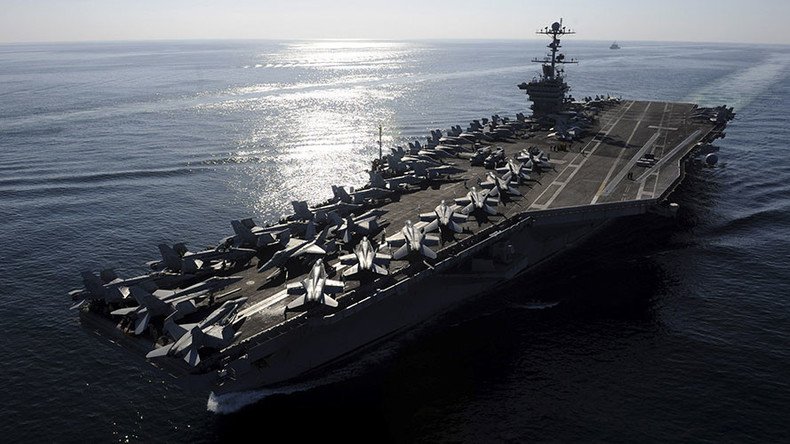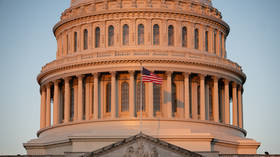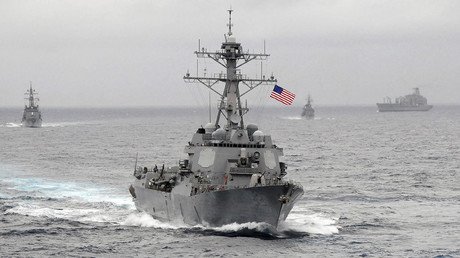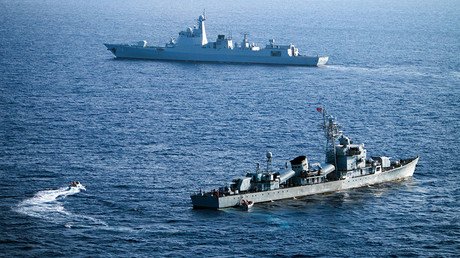Chinese spy ship ‘shadowing Stennis aircraft carrier’ as Japan, US & India hold joint drills

The USS Stennis command says a Chinese intelligence ship is shadowing the American air carrier taking part in the “Malabar” joint annual exercise in the Western Pacific. The joint naval exercise comes as China demonstrates growing interests in the region, as well as in the Indian Ocean.
The eight-day exercise has gathered 10 warships, including the 100,000-ton US aircraft carrier John C. Stennis with F-18 fighter jets, a Japanese helicopter carrier and Indian frigates off the Japanese Okinawan islands.
The Chinese spy ship has been shadowing the USS John C. Stennis’ task force group since the moment the American warships entered the South China Sea and patrolled its waters, the commander of the Stennis, Captain Gregory C. Huffman, told reporters aboard the carrier.
“There is a Chinese vessel about seven to 10 miles away,” Huffman said on Wednesday.
Pentagon chief to sail aircraft carrier through disputed South China Sea https://t.co/ScDPsTluAXpic.twitter.com/gk4zTL2SWe
— RT (@RT_com) April 15, 2016
On Wednesday, Tokyo accused Chinese observation ship of entering its territorial waters south of its southern Kyushu Island. In remarks published on the Chinese Foreign Ministry’s website, China refuted the accusation, citing the principle of freedom of navigation and stressing that the Chinese vessel was acting within international law.
A Japanese Maritime Self Defense Force officer told Reuters on condition of anonymity that American aircraft will be acting away from the main group of ships participating in the drills. This is needed to avert Chinese spy ship’s attention from the naval games and allow the exercise go on in the absence of close electronic supervision by the People’s Liberation Army, the source said, noting that the aircraft will become a sort of “decoy” for the Chinese.
US State Dept. accuses China & Russia of increasing global tensions https://t.co/sh5hPy5sTcpic.twitter.com/VctVProrJO
— RT (@RT_com) February 20, 2016
Allies of the US believe Beijing is projecting its naval power and territorial claims in the region with surface vessels and submarines. That’s why Japanese antisubmarine aircraft are also participating in the Malabar exercise.
India is participating in the drills largely because of the growing Chinese naval presence in the Indian Ocean and Beijing’s close contacts with Pakistan, India’s regional rival and longtime foe.
'Stuck in Cold War': Beijing says won’t play role in Hollywood-style movie directed by US military https://t.co/bIr4uUYsQw
— RT (@RT_com) May 30, 2016
China and Japan have a hot territorial dispute over islands of Senkaku (in Japan) or Diaoyu (in China) lying only 220 kilometers northeast of Taiwan in the South China Sea. Beijing views waters of the East China Sea and neighboring South China Sea as absolutely vital in terms of supply sea routes connecting the country to the rest of the world and territorial national security issues. The volume of ship-borne trade passing through its waters is estimated at $S5 trillion.
Tokyo complained about a Chinese frigate sailing within 38km of the coast of the Japanese-controlled Senkaku Islands. The Chinese ambassador was summoned to the Japanese Foreign Ministry over alleged violations of national territorial waters near disputed islands in the East China Sea. Chinese warships in the area are “rational and legal,” Beijing said.
Japan protests Beijing’s warships approaching disputed islands in E. China Sea https://t.co/nLwIGj1fNdpic.twitter.com/ZXaymc5PEe
— RT (@RT_com) June 9, 2016
Washington is deploying additional warships to East Asia to operate together with the Japan-based Seventh Fleet, a move coming “at a time of heightened tensions with China.”
In April, the Third Fleet's Pacific Surface Action Group deployed to East Asia was reinforced with the guided-missile destroyers USS Spruance and USS Momsen. Traditionally, the US Navy's Third Fleet based in San Diego, California, operates in the eastern side of the Pacific Ocean.
#China fumes after #Pentagon calls it top target of US 'freedom of navigation' ops https://t.co/01FPFfbtbQpic.twitter.com/WRRhuuXN2Z
— RT (@RT_com) April 27, 2016
The deployment comes amid a “context of uncertainty and angst in the region,” Japan's Nikkei Asian Review cited the commander of the US Pacific Fleet, Admiral Scott Swift, as saying on Tuesday, with an apparent nod to China.
In total, the US Pacific Fleet’s combined resources consist of 140,000 sailors, over 200 ships and 1,200 aircraft.














